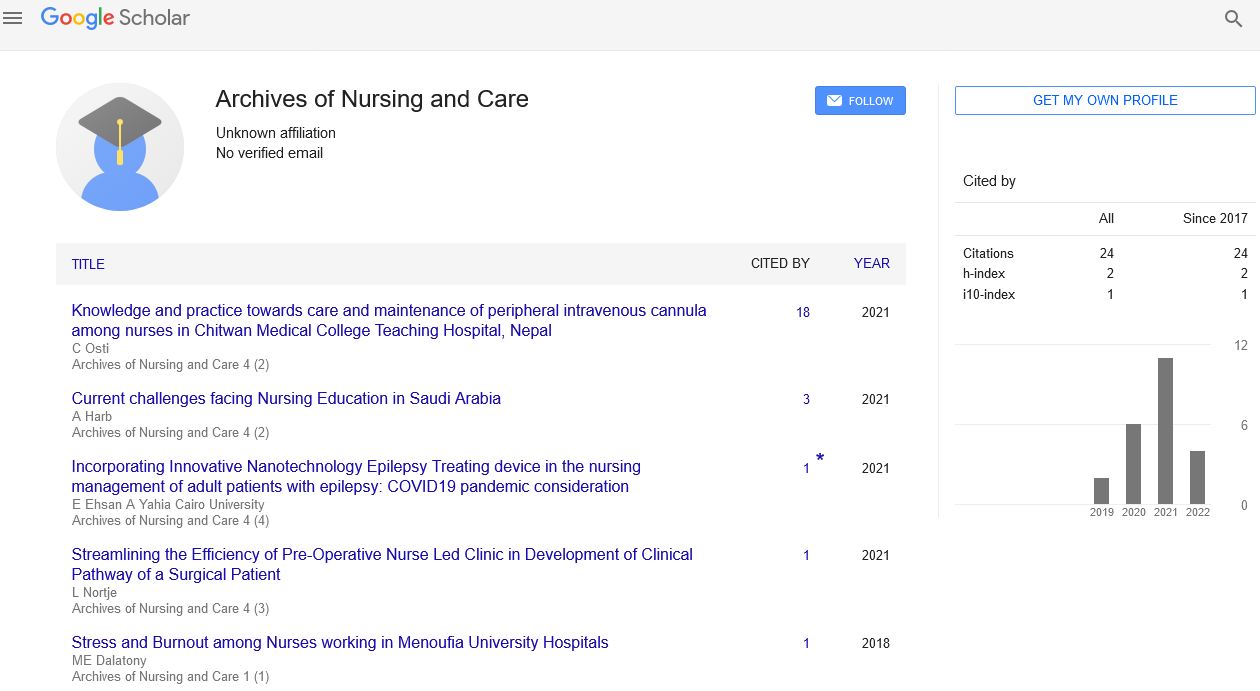Editorial - Archives of Nursing and Care (2023) Volume 6, Issue 3
Nursing Diagnosis in Improving Patient Outcomes: A Comprehensive Review of Current Practices and Future Directions
Jiang Zuo*
Emergency Department, Zhejiang Hospital, Hangzhou, Zhejiang, China
Emergency Department, Zhejiang Hospital, Hangzhou, Zhejiang, China
E-mail: Zuojiang@edu.rf.cn
Received: 02-June-2023, Manuscript No. OANC-23-96757; Editor assigned: 05-June-2023, PreQC No. OANC-23- 96757 (PQ); Reviewed: 19-June-2023, QC No. OANC-23-96757; Revised: 26-June-2023, Manuscript No. OANC-22- 96757 (R); Published: 30-June-2023; DOI: 10.37532/oanc.2023.6(3).79-81
Abstract
Nursing diagnosis is a critical aspect of nursing practice, and the use of computers in diagnosing patients has become increasingly popular in recent years. There are many advantages to using computerized nursing diagnosis, including increased accuracy, efficiency, and standardization of diagnoses. In this review article, we will explore the benefits of using computerized nursing diagnosis and discuss some of the challenges and limitations of this approach. In order to help pathologists quickly locate the lesion area, improve the diagnostic efficiency, and reduce missed diagnosis, a convolutional neural network algorithm for the optimization of emergency nursing rescue efficiency of critical patients was proposed. Specifically, three convolution layers and convolution kernels of different sizes are used to extract the features of patients' posture behavior, and the classifier of patients' posture behavior recognition system is used to learn the feature information by capturing the nonlinear relationship between the features to achieve accurate classification. By testing the accuracy of patient posture behavior feature extraction, the recognition rate of a certain action, and the average recognition rate of all actions in the patient body behavior recognition system, it is proved that the convolution neural network algorithm can greatly improve the efficiency of emergency nursing. The current feature extraction speed and recognition effect of intelligent diagnosis of menopausal women’s health care behavior, this paper proposes to use a cross-layer convolutional neural network to extract behavior features autonomously and use support vector machine multiclass behavior classifier to classify behavior. Compared with the feature images extracted by traditional methods, the behavioral features extracted in this paper are related to the individual menopausal women and have better semantic information, and the feature description ability in the time domain and the space domain has been enhanced.
Keywords
Nursing diagnosis • Menopausal syndrome • Patient care
Introduction
Menopausal syndrome is a common disease of menopausal people. Without obvious pathological factors, women have a continuous year of amenorrhea or permanent cessation of menstruation, which is called menopause. Before and after menopause, due to low estrogen levels, the aging of the ovaries affects the function of the hypothalamuspituitary- ovarian axis and causes menstrual disorders, hot flashes, sweating, irritability, depression, dizziness, fatigue, bone and joint muscle pain, and headaches. Palpitations, skin abnormalities, and many other discomforts are the clinical manifestations of menopausal syndrome. Menopausal women are often accompanied by obvious psychological disorders, such as anxiety, depression, and other emotional and psychological reactions, which seriously affect the quality of life of middle-aged and elderly women [1]. A survey shows that about 70% of women will have psychological and physical discomfort, showing varying degrees of anxiety, depression, and other physical and mental discomfort symptoms, and only 30% of menopausal women undergo self-regulation without the manifestations of menopausal syndrome.
The pathophysiological mechanism of menopause is generally believed to be the imbalance of neurotransmitters, hormones, cytokines, etc., caused by the hypothalamic-pituitaryovarian axis or adrenal dysfunction caused by the decrease of estrogen levels in the body. In addition, studies have found that endocrine disorders are not the only cause of menopausal syndrome [2]. In addition, it is also related to multiple factors such as family factors, cultural and social factors, psychological factors, and personality and behavior status. As the childbearing age increases, the number of ovarian follicles decreases. When the number of primordial follicles drops to an extremely low level, the key level of the feedback system will also decrease, and this series of endocrine changes occurs, disrupts the normal cyclical ovarian hormone secretion and ovulation, affects the highly coordinated interaction of ovarian hormones, pituitary gland and hypothalamus with normal menstrual cycle, and causes the hypothalamic-pituitary-ovarian axis to be confused [3]. This damage involves the transition period of the normal ovulation cycle, until the woman’s last menstrual period. In women during menopause, the number of follicles in the body is significantly reduced, and the remaining follicles are low in response to gonadotropin or completely lose their response, so the frequency of ovulation is reduced.
Aiming at the speed of feature extraction and recognition effect in behavioral intelligence diagnosis, combined with the characteristics of menopausal women’s behavior patterns, this paper proposes the use of crosslayer convolutional neural networks to autonomously extract features [4]. Combined with support vector machine multiclass behavior classification of nursing object behavioral intelligence, diagnosis programs are designed from the aspects of network structure, activation function, classification mechanism, and parameter selection. This article shows the hardware objects of the home care bed intelligent monitoring system and the care bed monitoring center software and shows the test results of the posture detection and control functions, timing control functions, menopausal women’s status monitoring functions, and remote diagnosis functions in the system. The results show that the designed system function has achieved the expected effect [5].
Discussion
One of the primary advantages of computerized nursing diagnosis is increased accuracy. Computer programs can use algorithms and data analytics to analyze patient data and identify potential diagnoses. These programs can take into account a broad range of factors, including patient demographics, medical history, and current symptoms, to generate a more accurate diagnosis. This can help nurses identify potential health risks or complications early on, leading to better patient outcomes [6].
Another advantage of computerized nursing diagnosis is increased efficiency. With the use of computer programs, nurses can quickly and easily identify potential diagnoses without spending hours poring over patient records. This allows nurses to focus on other aspects of patient care, such as developing treatment plans, providing education [7], and monitoring patient progress.
Computerized nursing diagnosis also offers increased standardization of diagnoses. With traditional nursing diagnosis, different nurses may have different interpretations of patient data, leading to variations in diagnosis and treatment [8]. With computerized diagnosis, diagnoses are based on standardized algorithms and data analytics, reducing the potential for variations in diagnosis.
Despite these benefits, there are also some challenges and limitations to using computerized nursing diagnosis. One challenge is that computer programs may not always take into account the full range of patient data [9], leading to potential inaccuracies in diagnosis. Additionally, computerized diagnosis can be time-consuming to set up and implement, requiring significant investment in technology and training [10].
Conclusion
In conclusion, computerized nursing diagnosis offers many benefits to nurses and patients, including increased accuracy, efficiency, and standardization of diagnoses. While there are some challenges and limitations to using this approach, the potential benefits make it a worthwhile investment for many healthcare organizations. As technology continues to evolve, it is likely that computerized nursing diagnosis will become even more widely used in the years to come.
References
- JanuškeviÄius ZI, StasiÅ«nas AS.Transmission of physiologicalinformationby telephone.Cor Vasa. 5, 152-155 (1963).
- Balogh N, Kerkovits G, Horvath Let al.Cardiac digital image loops and multimedia reports over the internet using DICOM.StudHealthTechnol Inform. 90,148-151(2002).
- Berdusis K.The state of the art: tele-echocardiography and telecardiology.Telemed Today. 7, 25-6(1999).
- Crowe B, Hailey D.Cardiac picture archiving and communication systems and telecardiology – technologies awaiting adoption.J Telemed Telecare. 8, 3-11(2002).
- El-Solh AA, Niederman MS, Drinka P.Nursing home acquired pneumonia: a review of risk factors and therapeutic approaches.Current Medical Research and Opinion. 26, 2707–2714(2010).
- Mills K, Nelson AC, Winslow BT et al.Treatment ofnursinghome-acquired pneumonia.American Family Physician. 79, 976–982(2009).
- Sarin J, Balasubramaniam R, Corcoran AM et al.Reducing the risk of aspiration pneumonia among elderly patients in long-term care facilities through oralhealthinterventions.Journal of the American Medical Directors Association.Current Medical Research and Opinion. 9, 128–135(2008).
- Sarin J, Balasubramaniam R, Corcoran AM et al.Reducing the risk of aspiration pneumonia among elderly patients in long-term care facilities through oralhealthinterventions.Journal of the American Medical Directors Association.Current Medical Research and Opinion. 9, 128–135(2008).
- Marik PE, Kaplan D.Aspiration pneumonia and dysphagia in the elderly. 124, 328–336(2003).
- Mintz AH, Kestle J, Rathbone MPet al.A randomized trial to assess the efficacy ofsurgeryin addition toradiotherapyin patients with a singlebrainmetastasis.Cancer.78, 1470–1476(1996).
Indexed at,Google Scholar,Crossref
Indexed at,Google Scholar,Crossref
Indexed at,Google Scholar,Crossref
Indexed at,Google Scholar,Crossref
Indexed at,Google Scholar,Crossref

